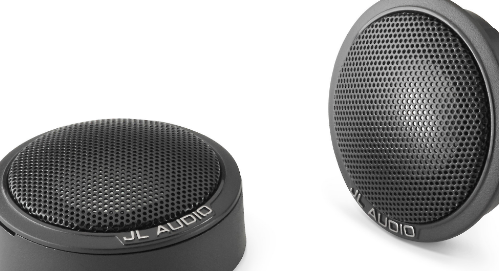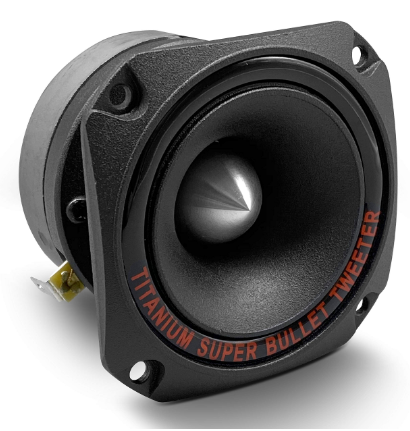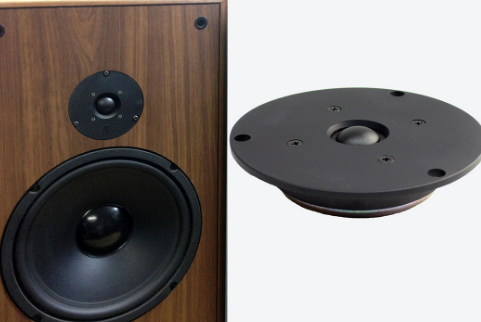You have probably heard the terms “tweeter,” “woofer,” “subwoofer,” and “midrange” without really understanding what they mean when purchasing a new home theater system, or soundbar, or even when looking for a new car.
Every sound you hear has a specific frequency, and while you might think that the human hearing range, as seen in the equalizer settings, is quite broad, it actually only extends from 20 Hz to 20,000 Hz. That’s the reason there are several types of speakers, a tweeter speaker is designed to reproduce high audio frequencies, typically from around 2,000 to 20,000 Hz (2KHz to 20KHz).
In this article, we will explain in detail how tweeters work and their role in a modern audio system and list some of the best available in the market nowadays.
Table of Contents
What Are Speaker Tweeters?
A particular kind of electromechanical loudspeaker called a tweeter creates music and sound in the higher (upper frequency) range. They are a good match for woofers and other speakers, like those used in a 2-way bookshelf speaker pair, that are unable to produce higher-pitched sounds.
Due to their small cone and smaller soundwave production, tweeters are small in size. Generally speaking, they work best when directed at the listener.
Although it depends on the specific speaker’s restrictions, most are restricted to a particular range, such as 3 to 20 kilohertz (kHz) at most. Around 20 Hz to 20 kHz is the typical human hearing range.
Kilohertz is a term used to describe either the frequency of the sound generated or the waveform’s cycles per second.
List of Tweeter Parts
Tweeters contain simple components when we break down their parts. They are primarily made of a magnet, just like any other electromagnetic loudspeaker.
The parts of a tweeter are:
1. Small Magnet and a Voice Coil
This is the heart of an electromagnetic loudspeaker. The tweeter’s magnet, which is small and attached directly to a voice coil, is a tweeter. These components turn the audio signal that the device receives into sound waves.
2. Dome
The dome is very important for the proper function of the tweeter, even though it may not seem at first. It is typical for the dome to be made of a stiff material, like a special kind of paper in a curved shape, because it will vibrate with the soundwaves that are reproduced by the small magnet and the voice coil.
3. Grill
The grill is the protection we usually see attached to the front of a tweeter. It serves to safeguard the loudspeaker. However, some tweeters lack grills.
4. Assembly
The assembly is what encapsulates every component of the tweeter. It must be constructed from a sturdy material because, as we previously stated, the voice coil and small magnet will cause it to vibrate as they produce sound waves. High-quality plastic is typically used in its construction.
How Do Tweeters Work
To understand exactly how tweeters work, we must understand the path of the audio signal until the electromagnetic loudspeaker reproduces it.
- Your stereo sends the audio signal to the crossover.
- The crossover divides the audio signal into various frequency spectrum segments and sends each segment to its corresponding components.
- The tweeter receives the audio signal with high-frequency.
- This audio signal is converted into sound waves by the tweeter’s voice coil and small magnet vibrating.
Because the tweeter driver is small, it can vibrate faster. This is crucial because, in order to accurately reproduce the audio signal, a tweeter’s internal components must vibrate at a rate that corresponds to the higher air vibration rates caused by high-frequency sound waves.
What is a Crossover?
The majority of car stereos contain a crossover as a component. Crossovers are responsible for dividing the audio signal into the different parts of the frequency spectrum and sending them to the corresponding components of the audio system.
For instance, the subwoofer receives the low frequencies, while the tweeter receives the midrange and high frequencies.
What is the Difference Between a Subwoofer and a Tweeter?
Subwoofers are meant to reproduce low frequencies. They are much bigger than tweeters because lower frequencies require more room to vibrate and travel through physical means rather than through air more effectively. Because of this, when we play a song with a lot of bass, the car begins to shake.
What Do Tweeters Do?
A tweeter and a woofer are typical components of an automobile stereo system. While a woofer will reproduce the low frequencies, a tweeter will reproduce all of the frequencies found within the mid and the high parts of the frequency spectrum. This includes instruments and elements such as vocals and guitars.
As we mentioned, tweeters have this purpose because higher frequencies don’t require as much space to travel as lower ones. The tweeter cone is much smaller than the woofer in a typical speaker set, as can be seen.

Advantages of Using a Tweeter
If you want a loud and bright sound from your sound system, with clear vocals, you must include a tweeter. The presence of this kind of loudspeaker in a contemporary audio system is crucial because these qualities are desired by many casual listeners and audio enthusiasts.
1. Tweeters Will Provide the Right Stereo Imaging to Your Audio System.
While subwoofers usually work in mono, tweeters are panned either left or right, to correctly reproduce the stereo image of a particular song and its elements. For this reason, tweeters are typically installed in the right and left doors of vehicles, for instance.
Where Are Tweeters Used?
Tweeters are, like we said, an essential part of any modern speaker or audio system. They are usually present in:
1. They Are Used in Modern Audio Monitors.
Audio monitors, generally used in studios, usually have a dedicated tweeter. This is because when working with music production and audio engineering, you need a clear response of the mids and highs.
2. They Are Used in Car Speakers.
Most coaxial car speakers feature one or more built-in tweeters. In the case of component speakers, you still have a tweeter, but it is usually built within its casing. To provide a better stereo image, tweeters are frequently mounted on car doors.
3. They Are Used in Home Theaters.
Home theaters benefit greatly from tweeters since movies and The dialogue in TV shows is frequently dense. A tweeter can undoubtedly improve the clarity and understandability of the human voice because it reproduces the highest frequencies in the frequency spectrum.
What Are the Different Types of Tweeters?
Not every tweeter is the same. The various available tweeter models differ in a number of ways. The size and type of material used in the majority of tweeters will vary. Domed, cone, and piezo tweeters are the three most common types of loudspeakers. The types of loudspeakers are explained below.
1. Dome Tweeters
These tweeters, as the name implies, usually feature a silk dome. This substance vibrates well with the sound waves generated by the electromagnetic coil and is very stiff and long-lasting. Silk dome tweeters produce an extremely pleasing and colorful sound. The most common variety of tweeter is this one. Some tweeters in this category might also have a dome made of PEI or mylar.
2. Cone Tweeters
This type of tweeter may be made from different materials, such as woven glass fiber, aluminum alloy, and titanium alloy. Depending on the substance, the sound’s hue and tone may change. In contrast to titanium cone tweeters, aluminum cone tweeters typically have a more neutral sound. In general, cone tweeters produce a fuller sound than dome tweeters. They are typically more expensive but smaller in size.
3. Piezo Tweeters
Piezo tweeters are frequently used in home theater setups due to their particular aesthetic. Additionally, the fact that piezo tweeters have the broadest frequency range of any tweeter type is a significant advantage. Piezo tweeters can reproduce mid- and low-frequency sound as well as high-frequency sound because of their broad frequency range.
Materials Used in Tweeters
For the tweeters, a wide variety of materials, including metal and textiles, are being used. Although metal dome tweeters appear more stylish than textile ones, this does not imply that they are superior. Even if a tweeter is made of expensive materials like titanium and aluminum, it should still perform better than one that is poorly made.
Below are some of the most common materials used for tweeters:
- Silk, textile, and other fabrics
- Mylar or other plastics
- Metal-coated plastics
- Metals: aluminum, titanium, and alloys
- Ceramics and ceramic-coated
The most popular materials for soft dome tweeters include silk and textile. Mid-to-high price range tweeters frequently contain titanium and other metals like aluminum. Due to the possibility of nice materials being deceptive, it is crucial to check all the specifications and the frequency response.
What Should I Keep in Mind When Buying a Tweeter Or Set of Speakers for My Car?

As we learned, tweeters are very important for your car stereo system to have bright and powerful sound quality. The extent to which your sound system meets your needs, however, depends on a variety of interrelated factors.
Type of the Tweeters
Most tweeters made for automotive usage are of the dome type because this is the most durable and sturdy type of speaker on the market. Cone or piezo tweeters may also be found in some high-end speakers.
Coaxial Vs. Component Speakers
Coaxial speakers are the most popular choice for car audio systems due to their convenience. The woofer and the tweeter are integrated within the same casing in a coaxial speaker set, making installation easier and lowering the cost.
With component speakers, the different parts of the speaker system (woofer, tweeter) are separated. Since you can, for instance, select each component to your preferences, this kind of speaker offers more customization options. A crossover and external amplifier are needed for this kind of speaker setup, which is more expensive.
Impedance
It is important to make sure that your desired tweeter/speakers match the impedance of your stereo or amplifier. Always select speakers whose impedance is greater than that of the amplifier is a general rule of thumb. For instance, if your amplifier has a minimum output impedance of 2 Ohm, your speaker should, as the name suggests, have that impedance as well.
Peak Power and RMS Power
Peak power refers, in simple terms, to the maximum power that a speaker can produce, while RMS power refers to an average. When buying a tweeter or speaker, you must match these specifications to the stereo system or external amplifier you’re using so that you max out your system’s performance.
Frequency Range and Response
Despite the fact that these two terms are similar and frequently confused for one another, they have different meanings. Frequency range refers to the range of frequencies your tweeter/speaker can produce, while frequency response, usually shown in a graph form, refers to which frequencies are more present in a particular device.
These specifications are necessary because they will determine how well the tweeter/speaker will reproduce each frequency in the frequency spectrum. In order to get the best sound quality, choose tweeters with a wide frequency range and strong midrange and highs. These are, after all, the fundamental frequencies that a tweeter needs to reproduce.
Budget
Last but not least, consider your budget. There are many options available today, and the most expensive tweeter or speaker may not always be the best choice for your specific application. For instance, Pioneer offers a few budget models that are very cost-effective and function just as well as high-end goods.
FAQs
What is the Difference Between Speakers and Tweeters?
A tweeter is a type of speaker. The term “speaker” is more inclusive because it encompasses everything from coaxial speakers to subwoofers. Tweeters are nothing more than speakers designed specifically to reproduce mid- and high-frequency sounds, enhancing the clarity and performance of your audio system.
Do I Need to Buy a Separate Tweeter If I’m Using a Coaxial Speaker?
No, you don’t need to. The majority of coaxial speakers include a woofer, one or more tweeters, and allow for full frequency reproduction.
What is the Advantage of Using a Component Speaker Set Versus a Coaxial One?
Component speaker sets allow you for more customization options, but they are usually much more expensive than their coaxial counterparts. In fact, coaxial speakers are advised for the majority of setups.
How Do I Stop My Tweeters from Blowing?
You must ensure that your tweeters are receiving the right power. The minimum output impedance of your amplifier should be matched with the impedance of your speakers, as we previously mentioned. Your tweeters won’t blow because of this.
Do Tweeters Play Vocals?
Yes. The human voice has a lot of content in the frequency range above 2 kHz, where tweeters typically perform best.
Do Tweeters Need An Enclosure?
Tweeters usually come inside their own enclosure, so you most likely won’t need one.
Do I Need An External Crossover in My Car Audio System?
It depends if your speaker system already features a built-in one or not. A built-in crossover is most likely included with a coaxial set of speakers if you’re using them. However, if you have component speakers, you might also need to purchase an external crossover and external amplifier.
Conclusion
As we learned, tweeters are essential to any high-quality audio system. Be it in a coaxial speaker, where it’s usually built-in over a woofer; Or in a component set, where the device has its enclosure and is generally paired with an external woofer and amplifier.

